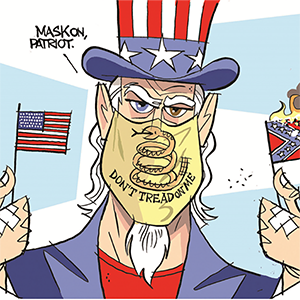Who stands to gain the most from new federal overtime rules?
Published in Slideshow World
Subscribe
Who stands to gain the most from new federal overtime rules?
New Biden administration rules have raised the maximum salary eligible for overtime pay and put in place a mechanism that ensures the salary threshold keeps pace with rising wages and prices.
As of July 1, 2024, hourly workers making the equivalent of $43,888 a year are eligible for overtime pay, up from $35,568, which will increase to $58,656 on Jan. 1, 2025. By 2027, the levels will be updated every three years to keep pace with worker salaries.
Today, overtime pay entitles workers to 1.5 times their regular wage for hours in excess of 40 they work in a week. Under the 1938 Fair Labor Standards Act, which established overtime pay and the minimum wage, workers were eligible for overtime if their pay fell below a certain threshold. From 1938 to 1975, that threshold was updated every five to nine years to keep pace with rising wages and prices.
But since 1975—when more than 60% of salaried workers qualified for overtime, according to an analysis by the Economic Policy Institute—those levels have been updated far less frequently. In recent years, the number of employees who qualify has plummeted to 15%.
In 2016, the Obama administration issued new rules that raised the overtime threshold to $47,476, which were to be revised every three years. However, the move faced stiff opposition from business groups claiming it hurt both businesses and workers. Officials from 21 states sued to block its passage and a Texas judge blocked it.
In 2019, the Trump administration lowered the threshold to $35,568 but didn't include a mechanism for automatic indexing, which would have let the value of the protection decay over time.
One of the goals of the increased pay levels is to address the practice of employers misclassifying employees as managers and supervisors to avoid paying them overtime. For instance, a fast food cashier might be an "assistant manager" but have no real authority and receive an annual salary that falls just below the previous threshold levels, disqualifying them from overtime.
From 2010 to 2021 the number of employees increased by 9% while the number of "managers" increased by 47%, according to an analysis of Department of Labor data by the National Bureau of Economic Research. In addition, some of the managerial titles cited in the analysis were quite dubious, such as "carpet shampoo manager" and "assistant bingo manager."
The new rules will secure overtime protection for an estimated 4.3 million workers. But not everyone is happy with that. Small business trade groups say that it puts a burden on their bottom line at a time when they're already struggling with higher prices and borrowing costs. In a statement, the National Federation of Independent Business called the move "bureaucratic government overreach" and vowed to join a legal challenge against it.
Labor economists dispute the notion that the changes will harm the economy. "Whenever a labor standard is increased, there is always a chorus of business that says the sky will fall and it never does," Heidi Shierholz, president of the Economic Policy Institute, a Washington D.C.-based progressive think tank, told Stacker. "Somehow we have labor standards that improve over time."
Wysa analyzed Bureau of Labor Statistics data to illustrate which workers will benefit the most from new overtime rules taking effect in phases this summer and at the start of 2025. The analysis ranked occupations in which the typical, or median, worker earns within $10,000 of the threshold receiving overtime protection under the new rules.
Visit thestacker.com for similar lists and stories.
July rule benefits workers in jobs with repetitive, manual labor focus
Certain industries will see a greater impact than others. "Those industries have a lot of workers who are disproportionately in that band. They are manager-supervisors, they're not earning very much, earning between the old threshold, which was extremely low, and the new Biden threshold," said Shierholz."Those are industries where there are white-collar bona fide managers who just don't earn that much money."
A number of professions have difficult working conditions where employees face greater strain when asked to work beyond 40 hours a week.
"Long shifts, low autonomy, mandatory overtime, and being forced to work weekends, nights, and holidays prompts many nurses to look for other jobs," Carol J. Huston writes in "Professional Issues in Nursing."
Administrative, health care workers to be included in second step-up in overtime threshold
In some industries, the changes will help mitigate pay inequities and exploitative behavior, according to labor law experts. "Drivers for both food delivery and other delivery services are frequent victims of wage theft," according to injury law firm Morgan & Morgan. "If you're paid a daily rate (example: $100 per day's worth of work) that might not account for the actual number of hours you're on the job."
Some of the affected industries, such as construction-related fields, are still struggling with pandemic-related price volatility, supply chain disruptions, and labor shortages and have been impacted by high interest rates and restrictive lending.
The Biden administration's new overtime rules are set to boost pay protections for millions of workers and restore their level to the original methodology, while adding a new mechanism to automatically recalculate the level based on inflation. Critics in the business community argue this move will pinch small businesses already battling inflation and higher borrowing costs. But labor advocates see this as a long-overdue fix that will curb worker misclassification and wage theft, especially in industries like fast food and retail, where lower-wage managers have been particularly vulnerable.
Story editing by Alizah Salario. Additional editing by Kelly Glass and Elisa Huang. Copy editing by Tim Bruns.
This story originally appeared on Wysa and was produced and distributed in partnership with Stacker Studio.









Comments